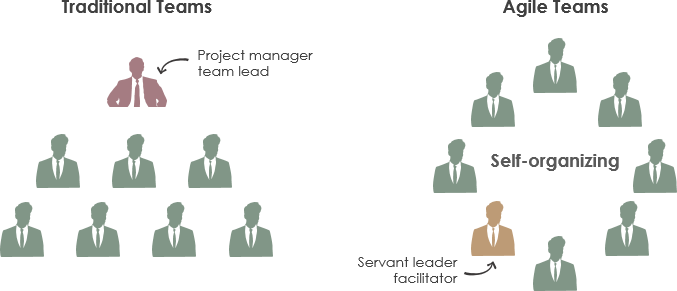Các nhóm Scrum là tự tổ chức và đa chức năng.
Các nhóm tự tổ chức chọn cách tốt nhất để hoàn thành công việc của họ, thay vì bị chỉ đạo bởi những người bên ngoài nhóm.
Các nhóm đa chức năng có tất cả các năng lực cần thiết để hoàn thành công việc mà không phụ thuộc vào những người không thuộc nhóm.

Trong bản cập nhật hướng dẫn scrum mới, một trong những thay đổi chính đã được thực hiện từ cụm từ rằng các nhóm phải “tự tổ chức” sang cụm từ rằng họ phải “tự quản lý”.
Tự Tổ Chức vs Tự Quản Lý
Trong một nhóm tự tổ chức, các thành viên sở hữu “cách” để thực hiện công việc và quyết định “ai” sẽ thực hiện công việc trong nhóm. Bạn sẽ thường thấy các khái niệm tự tổ chức được áp dụng cho các môi trường linh hoạt, nơi mà người sở hữu sản phẩm nắm giữ các ưu tiên của công việc (tức là, “cái gì”) và nhóm nắm giữ “cách” và “ai.”
Trong một nhóm tự quản lý, các thành viên có quyền tự quyết về cách, ai và cái gì để làm. “Cái gì” đề cập đến việc nhân viên ưu tiên các hoạt động công việc. Trong mỗi trường hợp, có một cấp độ nhiệm vụ của “cái gì” và “tại sao” của tổ chức được xác định bởi lãnh đạo công ty, cả hai đều phải nhất quán.
Nói cách khác, nhóm Scrum tự quản lý các quyết định nội bộ về ai làm gì, khi nào và như thế nào
Do đó
- Các nhóm tự tổ chức = quyết định: làm thế nào để hoàn thành?
- Các nhóm tự quản lý = quyết định: làm thế nào, khi nào và cái gì để hoàn thành?
Những thay đổi đối với Scrum trong năm 2020 sẽ giúp tổ chức các nhóm và cho phép họ quản lý công việc của chính mình. Thành công của tổ chức nằm ở việc cắt giảm thủ tục rườm rà và xác định ranh giới rõ ràng.
This post is also available in Deutsch, English, Español, فارسی, Français, Bahasa Indonesia, 日本語, Polski, Portuguese, Ру́сский, 简体中文 and 繁體中文.













